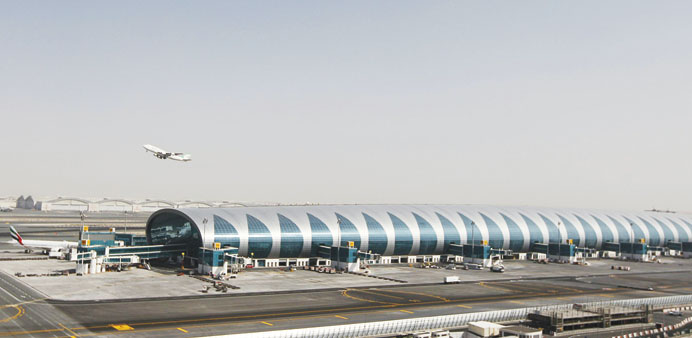A plane takes off near the new terminal dedicated for A380 aircraft at the concourse in Dubai International Airport (DXB) in this January 7, 2013 photo. DXB, which is being expanded to handle 90mn passengers a year, could be shut in coming decades to focus traffic on a new super-hub under construction with as much as twice that capacity.
Bloomberg/Dubai
Dubai International airport, which is being expanded to handle 90mn passengers a year, could be shut in coming decades to focus traffic on a new super-hub under construction with as much as twice that capacity.
Dubai Airports won’t retain the existing base if owning two hubs hampers the take up of flights at its new Al Maktoum site, and could find “alternative purposes” for the prime real estate, chief executive officer Paul Griffiths said in an interview.
The airport authority is evaluating plans to accelerate construction of Al Maktoum and make room for top client Emirates to move in before 2025, and could lift capacity to 200mn travellers a year to boost its appeal, Griffiths said. Discount carriers Jazeera Airways of Kuwait and Wizz Air Ltd of Hungary have agreed to use the facility, which opens October 27, and talks are ongoing with at least two more possible users, he said.
“What we’re trying to work out right away is whether there’ll be an impact on capacity at Dubai International if we continue to operate two airfields,” Griffiths said last month. “We might end up with a situation where two give you less capacity than if you concentrate all your operations on a single airport. If that turns out to be the case, clearly we won’t be operating two. But it’s not a decision that has to be rushed.”
Al Maktoum airport, named after the emirate’s former ruler Sheikh Maktoum bin Rashid al-Maktoum and located at the Dubai World Central aviation complex to the south of the main urban area, is scheduled to open to traffic on October 27, Griffiths said.
Saudi Arabian low-cost operator NasAir, which had been touted as an initial client, is undergoing management changes and may rethink its strategy, he said. Jazeera Air has announced that it would serve the airport twice weekly from October 31.
The Kuwaiti carrier and two other potential users represent different regions and operating models, with one of the unnamed parties not currently serving Dubai, Griffiths said.
Airlines are “notoriously unadventurous” in adopting new airports, though once the first few move many more will likely follow suit and quickly take up Al Maktoum’s initial capacity of just 5mn people a year, Griffiths said.
From that base Dubai World Central aims to become the world’s biggest air hub once fully open, with five runways able to handle 160mn passengers and 12mn tonnes of freight. The Al Maktoum airport at its centre has so far been restricted to cargo operations, which it has been handling since June 2010.
Dubai International, or DXB, hosts 155 carriers and expects to attract 65.4mn passengers in 2013, double the total it had when Griffiths joined from London’s Gatwick airport in 2007.
Still, the airport, home to Emirates, the world’s biggest international airline, will reach peak capacity in 2018 even after its own $7.8bn upgrade, which includes the Concourse D project, due to open in early 2015 after completion next year, and the site’s future can’t be guaranteed, Griffiths said.
While becoming a two-hub city is “a big statement in world terms,” ranking Dubai among the likes of multi-airport metropolises like Tokyo and London, according to the CEO, Dubai International is constrained by urban development on all sides.
“If we don’t use it as a major airport in 10 or 12 years’ time it will be a very valuable piece of real estate, very close to the city centre, so we could use DXB for alternative purposes,” he said in the interview. “Options are on the table for consideration. But it’s not a decision we have to make now.”
The new airport, 35km (22 miles) to the south near the Jebel Ali industrial zone, needs to reach an annual capacity of 100mn passengers before Emirates - which might then be carrying 70mn people - can move in, according to Griffiths, who said that shifting the carrier by 2020 would be “very aggressive” and that faster work is needed even to improve on the 2025-2027 period currently targeted. Early projections put the hub’s capacity at only 80mn by 2027.
Neither are split operations an option for Emirates, according to Griffiths, with the airline’s business model based around the ease of passenger transfers between regular waves of intercontinental flights served by wide-body planes including the world’s biggest fleet of Airbus SAS A380 superjumbos.
In parallel with accelerated construction, which might entail modular terminals to allow for staged capacity growth, Dubai Airports is exploring development of the new facility beyond its maximum design capacity of 160mn people - more than twice the number who currently use London Heathrow, the busiest aviation hub in Europe - with a figure of 200mn passengers regarded as a possibility, Griffiths said.
“The idea is to future-proof it,” he said. “We could get to a point where we greatly exceed the largest airport in terms of overall capacity. This is Dubai. There are plenty of examples here where we set ambitious plans and actually exceed them, with the rest of the world asking ‘How on earth did they do that?’”

